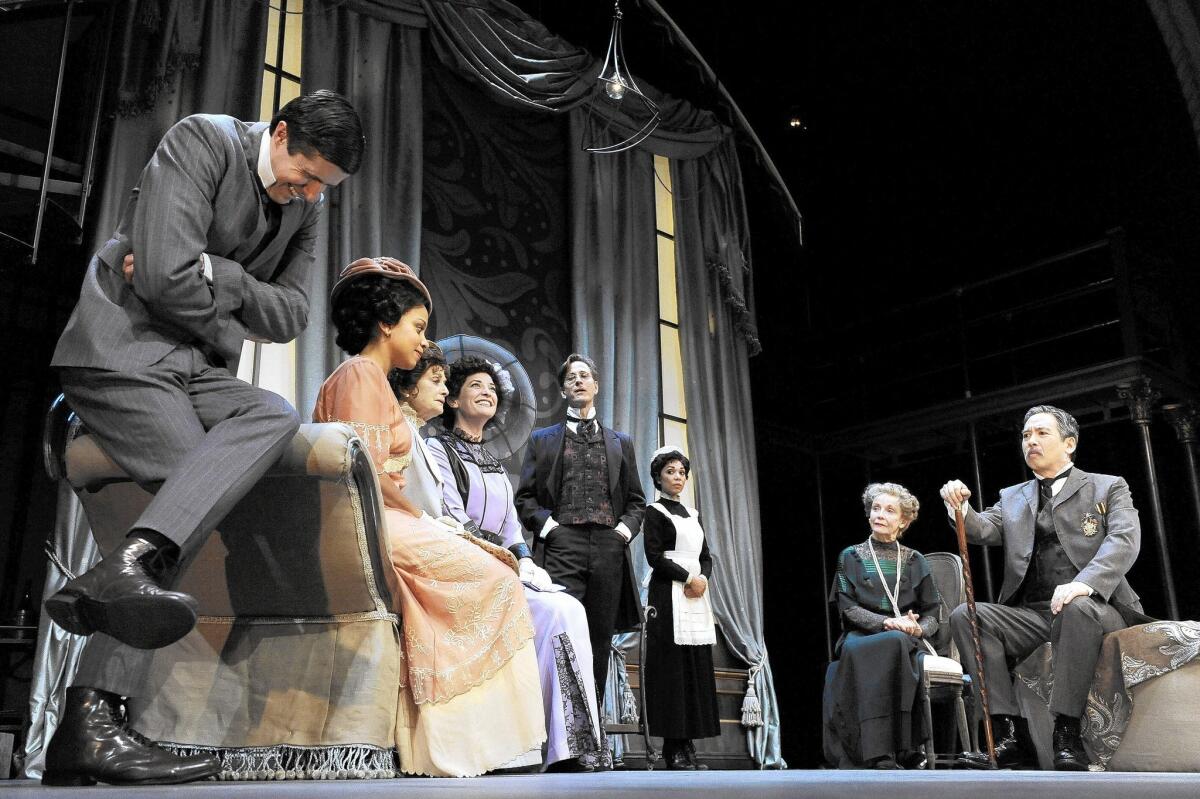Pasadena Playhouse’s ‘Pygmalion’ is more a rethinking than a revival

“I’m actually wondering if I need to put a giant sign in the lobby of the Pasadena Playhouse that says, ‘This is not like “My Fair Lady,” ’ “ says Jessica Kubzansky, who is directing a revival of George Bernard Shaw’s “Pygmalion” there.
“My Fair Lady,” the 1956 Lerner and Loewe musical starring Rex Harrison and Julie Andrews that was made into the 1964 film starring Harrison and Audrey Hepburn, is the best-known adaptation of Shaw’s decidedly less sentimental “Pygmalion.”
In “My Fair Lady,” after phonetics professor Henry Higgins plucks cockney flower girl Eliza Doolittle out of the gutter and trains her to pass as a member of high society, it’s implied that the two will eventually marry.
This was exactly what Shaw didn’t want “Pygmalion” to imply. All his life, he resisted pressure from the softhearted public to bring his characters together. Midway through the play’s 1914 London run, he reprimanded the actor playing Henry for adding flirtatious gestures to the astringent final scene. He sought to preempt further rebellion by appending an essay to the published play in 1916 outlining the remainder of Henry and Eliza’s lives (In short, not married to each other.).
Shaw refers to the Greek myth about a sculptor and his statue-come-to-life that inspired the play. “Galatea never does quite like Pygmalion: his relation to her is too godlike to be altogether agreeable,” he concludes.
“I hate that essay,” admits Paige Lindsey White, who is playing Eliza to Bruce Turk’s Henry. “Shaw left an instruction manual: ‘This is how you play with my dolls.’”
So it must be asked: Will Kubzansky’s production adhere to Shaw’s vision that Eliza and Henry not fall in love?
Kubzansky takes a beat. “We’re sticking to Shaw’s vision that they not get married,” she replies carefully, suppressing a smile. “You’re asking a different question.”
Kubzansky and White burst into laughter. They’ve arrived a few hours early at their rehearsal space, on the campus of Pasadena City College, to discuss the rewards and challenges of doing “Pygmalion” in this day and age. They’ve worked together many times before, most recently in Kubzansky’s “R II,” her adaptation of Shakespeare’s “Richard II,” in which White starred as the usurper, Bolingbroke, and they exude mutual enthusiasm.
In a reversal of their theatrical roles, Kubzansky takes the spotlight during the interview while White listens raptly, intervening from time to time to correct any excessive humility on her director’s part.
When Kubzansky downplays her own role in adapting Shakespeare, White argues, “It was a reexamining of the play as a character piece as opposed to a history.” Kubzansky compares White and Turk to “two Stradivariuses.” When White steps away for a moment, Kubzansky confides, sotto voce, “I think Paige is the next Meryl Streep.”
Kubzansky has served as co-artistic director, with Michael Michetti, of the Theatre @ Boston Court in Pasadena since its inception in 2003, directing numerous productions there as well as at a broad swath of theaters in the Los Angeles area, across the country and even around the world.
She has built a reputation for vivid stagings of new plays (such as Sheila Callaghan’s “Everything You Touch”) and provocative interpretations of classics (such as “R II,” and a “Macbeth” at Antaeus Company in which the regicidal couple were portrayed as newly bereaved parents).
A significant portion of her work explores gender roles, often with a subversive slant, but when asked if she considers herself a feminist, she seems taken aback.
“If I were to label myself I’d say that I’m a humanist,” she says after some thought. “Although I don’t even know what that means. I’m in love with the totalitarian ... the totalitarity?... the totality of humanity, with all its ... I love flaws!”
A distinctive figure on the theater scene with her bright red curls, black-framed glasses and generous hugs, Kubzansky comes across in conversation as passionate, inspired, funny and erudite but unpretentious. She appears to enjoy her work to the point of glee. “I still walk down the halls of Boston Court, giggling, going ‘Really?’”
She arrived at directing through playwriting, which she studied, along with fiction, as an undergraduate at Johns Hopkins. Edward Albee directed her first play there. After graduation, she took a shot at directing it herself, which led to more directing jobs. Eventually, she earned an MFA in directing at CalArts, which she chose because “it was one of the only places where the professors were actually working in the field.”
Kubzansky last worked at the Pasadena Playhouse in 2009, directing Theresa Rebeck’s “Mauritius.” Ever since, she says, she and artistic director Sheldon Epps have been discussing her next Playhouse project.
“Sheldon mentioned Shaw,” she recalls. “We brainstormed a lot of exciting titles, and ‘Pygmalion’ was the one we arrived at. He may even have been the one who proposed it. But I love Shaw so much. I did ‘Heartbreak House’ years ago at the Colony, and I always want more, because I’m in love with language.
“And really, when I started thinking about ‘Pygmalion’ through a modern lens,” she says, “the question of language as access is so present in our culture. The way we speak informing who we are, what doors are open or closed to us, if we may amend the way we speak to fit in with a different group. And there’s a whole other language now on Twitter. It’s a completely new communication. If you don’t know what ‘hashtag’ means, there’s a whole segment of society you can’t really communicate with.”
Just as it’s beginning to sound as though Kubzansky’s production will resemble the short-lived ABC sitcom “Selfie” (quick recap: fuddy-duddy ad exec Henry takes frivolous social-media addict Eliza under his wing), she matter-of-factly adds, “We have to do the play in the era in which it’s set, because it’s a huge comment about women, and the societal mores around Eliza’s choices are absolutely specific to the time, and so to set it today, I think, would rob it of some of the ironic constrictions that elevating Eliza ends up making for her.”
Kubzansky, having given this choice some thought, warms to her subject. “If Henry took someone who had today’s equivalent of cockney and taught her to speak well, marriage is absolutely not her only option. She can go be a lawyer. Whenever you direct a play, it’s really important to understand the stakes of the time frame. With all due respect to my colleagues who have done this, if you set ‘The Merchant of Venice’ today, Portia does not need to disguise herself as a man to go into the courtroom. There’s a set of given circumstances that give the play its danger. Certainly in ‘Pygmalion,’ making a mistake in the drawing room is a very high-stakes event. When it’s life or death whether or not you sit correctly and say the right thing, then we’re on the ride. As soon as it doesn’t matter, then we don’t care, either, and it’s boring.”
“I think it’s absolutely a contemporary story, but you’re going to have to extrapolate because they’re going to wear long dresses and frock coats,” Kubzansky concludes.
That’s not to say that those dresses and frock coats will be without their Kubzansky touch. She has worked closely with her costume designer, Leah Piehl, and her set designer, Stephanie Kerley Schwartz, to ensure that the visual elements subtly echo her interpretation.
“Our take on the play is that Henry is taking Eliza out of one cage and putting her in another,” she explains. So Eliza’s costumes are inspired by “a lot of modern S&M runway stuff” and the gritty, industrial set has “an almost steampunk aesthetic.”
Kubzansky mentions that she was on the phone for hours the night before with Piehl discussing a possible alteration to the neckline of one of Eliza’s dresses. “Big debate raging right now,” she adds lightly. “There’s a moment in every process where I say, ‘People have no idea what it takes to do a play.’”
For White, a versatile rising actor with classical features, large, luminous eyes and an air of thoughtful serenity, taking on the famous role of Eliza Doolittle is a little intimidating.
“I’ve had Julie Andrews memorized in my head since I could sing along to something. So it’s breaking out of the idea of her playing it and making it real to you,” White says.
One of her greatest challenges is “finding Eliza’s voice” — both literally and metaphorically — especially since Eliza speaks “almost like three different characters” over the course of the play. “But I’m trying to find all of her in it,” says White.
Shaw’s writing, as entertaining on the page as on the stage, doesn’t always make it easy. One stage direction reads, “Eliza’s beauty becomes murderous.”
“Yeah, I’ll do all of that,” says White with a shrug.
More to Read
The biggest entertainment stories
Get our big stories about Hollywood, film, television, music, arts, culture and more right in your inbox as soon as they publish.
You may occasionally receive promotional content from the Los Angeles Times.










